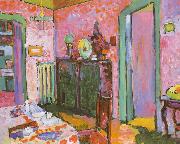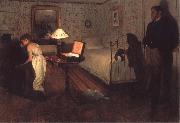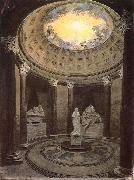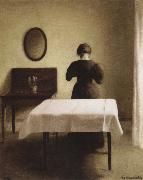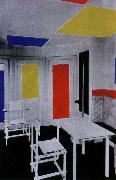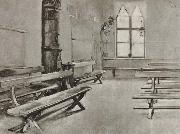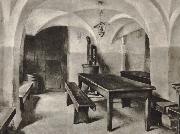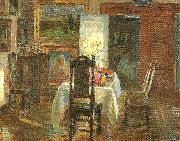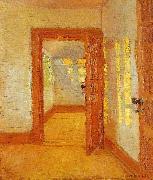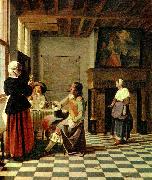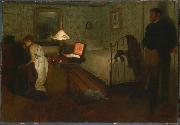Wholesale Oil Painting Reproductions No Minimum and Door to Door! |
|||||||||||
|
|
|||||||||||

|
|||||||||||
|
|
|
||||||||
All Wassily Kandinsky Oil Paintings |
||||||||
|
|
||||||||
|
|
||||||||
|
Artist Introduction: 1866-1944
Wassily Kandinsky Galleries
was a Russian painter, printmaker and art theorist. One of the most famous 20th-century artists, he is credited with painting the first modern abstract works.
Born in Moscow, Kandinsky spent his childhood in Odessa. He enrolled at the University of Moscow and chose to study law and economics. Quite successful in his profession??he was offered a professorship (chair of Roman Law) at the University of Dorpat??he started painting studies (life-drawing, sketching and anatomy) at the age of 30.
In 1896 he settled in Munich and studied first in the private school of Anton Azbe and then at the Academy of Fine Arts, Munich. He went back to Moscow in 1914 after World War I started. He was unsympathetic to the official theories on art in Moscow and returned to Germany in 1921. There he taught at the Bauhaus school of art and architecture from 1922 until the Nazis closed it in 1933. He then moved to France where he lived the rest of his life, and became a French citizen in 1939. He died at Neuilly-sur-Seine in 1944.
|
||||||||
|
|
||||||||
|
Interior Painting ID:: 2133 |
1909
Lenbachhaus, Munich |
|||||||
Height Width |
INS/CM Quality |
|||||||
|
X |
| |||||||
|
|
||||||||
All Edgar Degas Oil Paintings |
||||||||
|
|
||||||||
|
|
||||||||
|
Artist Introduction: French Realist/Impressionist Painter and Sculptor, 1834-1917
French painter, draughtsman, printmaker, sculptor, pastellist, photographer and collector. He was a founder-member of the Impressionist group and the leader within it of the Realist tendency. He organized several of the group exhibitions, but after 1886 he showed his works very rarely and largely withdrew from the Parisian art world. As he was sufficiently wealthy, he was not constricted by the need to sell his work, and even his late pieces retain a vigour and a power to shock that is lacking in the contemporary productions of his Impressionist colleagues. |
||||||||
|
|
||||||||
|
|
Interior Painting ID:: 49167 |
mk194
c.1874
Oil on canvas
81.3x114.3cm
|
||||||
Height Width |
INS/CM Quality |
|||||||
|
X |
| |||||||
|
|
||||||||
All Joseph Mallord William Turner Oil Paintings |
||||||||
|
|
||||||||
|
|
||||||||
|
Artist Introduction: English Romantic Painter, 1775-1851
Joseph Mallord William Turner (23 April 1775 ?C 19 December 1851) was an English Romantic landscape painter, watercolourist and printmaker, whose style is said to have laid the foundation for Impressionism. Although Turner was considered a controversial figure in his day, he is now regarded as the artist who elevated landscape painting to an eminence rivalling history painting.
Turner's talent was recognised early in his life. Financial independence allowed Turner to innovate freely; his mature work is characterised by a chromatic palette and broadly applied atmospheric washes of paint. According to David Piper's The Illustrated History of Art, his later pictures were called "fantastic puzzles." However, Turner was still recognised as an artistic genius: the influential English art critic John Ruskin described Turner as the artist who could most "stirringly and truthfully measure the moods of Nature." (Piper 321)
Suitable vehicles for Turner's imagination were to be found in the subjects of shipwrecks, fires (such as the burning of Parliament in 1834, an event which Turner rushed to witness first-hand, and which he transcribed in a series of watercolour sketches), natural catastrophes, and natural phenomena such as sunlight, storm, rain, and fog. He was fascinated by the violent power of the sea, as seen in Dawn after the Wreck (1840) and The Slave Ship (1840).
Turner placed human beings in many of his paintings to indicate his affection for humanity on the one hand (note the frequent scenes of people drinking and merry-making or working in the foreground), but its vulnerability and vulgarity amid the 'sublime' nature of the world on the other hand. 'Sublime' here means awe-inspiring, savage grandeur, a natural world unmastered by man, evidence of the power of God - a theme that artists and poets were exploring in this period. The significance of light was to Turner the emanation of God's spirit and this was why he refined the subject matter of his later paintings by leaving out solid objects and detail, concentrating on the play of light on water, the radiance of skies and fires. Although these late paintings appear to be 'impressionistic' and therefore a forerunner of the French school, Turner was striving for expression of spirituality in the world, rather than responding primarily to optical phenomena.
Rain, Steam and Speed - The Great Western Railway painted (1844).His early works, such as Tintern Abbey (1795), stayed true to the traditions of English landscape. However, in Hannibal Crossing the Alps (1812), an emphasis on the destructive power of nature had already come into play. His distinctive style of painting, in which he used watercolour technique with oil paints, created lightness, fluency, and ephemeral atmospheric effects. (Piper 321)
One popular story about Turner, though it likely has little basis in reality, states that he even had himself "tied to the mast of a ship in order to experience the drama" of the elements during a storm at sea.
In his later years he used oils ever more transparently, and turned to an evocation of almost pure light by use of shimmering colour. A prime example of his mature style can be seen in Rain, Steam and Speed - The Great Western Railway, where the objects are barely recognizable. The intensity of hue and interest in evanescent light not only placed Turner's work in the vanguard of English painting, but later exerted an influence upon art in France, as well; the Impressionists, particularly Claude Monet, carefully studied his techniques. |
||||||||
|
|
||||||||
|
|
Interior Painting ID:: 54873 |
mk238
1810
watercolour
64x49cm
|
||||||
Height Width |
INS/CM Quality |
|||||||
|
X |
| |||||||
|
|
||||||||
All Vilhelm Hammershoi Oil Paintings |
||||||||
|
|
||||||||
|
|
||||||||
|
Artist Introduction: Danish Painter, 1864-1916, was a painter born in Copenhagen, Denmark known for his poetic, low-key portraits and interiors.The son of a well-to-do merchant, Christian Hammershoi and his wife, Frederikke (nee Rentzmann), Vilhelm studied drawing from the age of eight with Neils Christian Kierkegaard and Holger Gronvold, as well as painting with Vilhelm Kyhn, before embarking on studies with Frederik Vermehren and others at the Royal Danish Academy of Fine Arts. From 1883 to 1885, he studied with Peder Severin Kroyer. |
||||||||
|
|
||||||||
|
|
interior Painting ID:: 56368 |
mk247
1898,oil on canvas,20.25x18.125 in,51.5x46 cm,nationalmuseum ,stockholm,sweden |
||||||
Height Width |
INS/CM Quality |
|||||||
|
X |
| |||||||
|
|
||||||||
All Piet Mondrian Oil Paintings |
||||||||
|
|
||||||||
|
|
||||||||
|
Artist Introduction: Dutch
1872-1944
Piet Mondrian Location
was a Dutch painter.
He was an important contributor to the De Stijl art movement and group, which was founded by Theo van Doesburg. He evolved a non-representational form which he termed Neo-Plasticism. This consisted of a grid of vertical and horizontal black lines and the use of the three primary colours.
When 47-year-old Piet Mondrian left his artistically conservative native Holland for unfettered Paris for the second and last time in 1919, he set about at once to make his studio a nurturing environment for paintings he had in mind that would increasingly express the principles of Neo-Plasticism about which he had been writing for two years. To hide the studio's structural flaws quickly and inexpensively, he tacked up large rectangular placards, each in a single color or neutral hue. Smaller colored paper squares and rectangles, composed together, accented the walls. Then came an intense period of painting. Then again he addressed the walls, repositioning the colored cutouts, adding to their number, altering the dynamics of color and space, producing new tensions and equilibrium. Before long, he had established a creative schedule in which a period of painting took turns with a period of experimentally regrouping the smaller papers on the walls, a process that directly fed the next period of painting. It was a pattern he followed for the rest of his life, through wartime moves from Paris to London??s Hampstead in 1938 and 1940, across the Atlantic to Manhattan.
At 71 in the fall of 1943, Mondrian moved into his second and final New York studio at 15 East 59th Street, and set about again to create the environment he had learned over the years was most congenial to his modest way of life and most stimulating to his art. He painted the high walls the same off-white he used on his easel and on the seats, tables and storage cases he designed and fashioned meticulously from discarded orange and apple-crates. He glossed the top of a white metal stool in the same brilliant primary red he applied to the cardboard sheath he made for the radio-phonograph that spilled forth his beloved jazz from well-traveled records, Visitors to this last studio seldom saw more than one or two new canvases, but found, often to their astonishment, that eight large compositions of colored bits of paper he had tacked and re-tacked to the walls in ever-changing relationships constituted together an environment that, paradoxically and simultaneously, was both kinetic and serene, stimulating and restful. It was the best space, Mondrian said, that he had ever inhabited. Tragically, he was there for only a few months: he died of pneumonia in February 1944. |
||||||||
|
|
||||||||
|
|
interior Painting ID:: 56638 |
mk248 en arkitektonniisk modell i de stil,med markerade likbeter med mondrians deign princper. |
||||||
Height Width |
INS/CM Quality |
|||||||
|
X |
| |||||||
|
|
||||||||
All Gustaf Cederstrom Oil Paintings |
||||||||
|
|
||||||||
|
|
||||||||
|
Artist Introduction: Swedish Painter, 1845-1933,was a Swedish painter, most known for his painting Karl XII:s likfärd (The funeral transport of Charles XII). He was born and raised in Stockholm. His father was Carl Emanuel Cederström and his mother was Carolina Fredrika Theresia af Ugglas. He married Amalia Katarina Jaeder in 1878 |
||||||||
|
|
||||||||
|
|
interior Painting ID:: 57449 |
mk254
interior,fran laxbrostugan pa skansen .studie i olja till likvakan i tistedalen,1893 |
||||||
Height Width |
INS/CM Quality |
|||||||
|
X |
| |||||||
|
|
||||||||
All Gustaf Cederstrom Oil Paintings |
||||||||
|
|
||||||||
|
|
||||||||
|
Artist Introduction: Swedish Painter, 1845-1933,was a Swedish painter, most known for his painting Karl XII:s likfärd (The funeral transport of Charles XII). He was born and raised in Stockholm. His father was Carl Emanuel Cederström and his mother was Carolina Fredrika Theresia af Ugglas. He married Amalia Katarina Jaeder in 1878 |
||||||||
|
|
||||||||
|
|
interior Painting ID:: 57661 |
mk254
interior.studie till hos de husvilla,1889.prins eugens samling,valdemarsudde |
||||||
Height Width |
INS/CM Quality |
|||||||
|
X |
| |||||||
|
|
||||||||
All Gustaf Cederstrom Oil Paintings |
||||||||
|
|
||||||||
|
|
||||||||
|
Artist Introduction: Swedish Painter, 1845-1933,was a Swedish painter, most known for his painting Karl XII:s likfärd (The funeral transport of Charles XII). He was born and raised in Stockholm. His father was Carl Emanuel Cederström and his mother was Carolina Fredrika Theresia af Ugglas. He married Amalia Katarina Jaeder in 1878 |
||||||||
|
|
||||||||
|
|
interior Painting ID:: 57663 |
mk254
interior,studie till.hos de husvilla.1889 |
||||||
Height Width |
INS/CM Quality |
|||||||
|
X |
| |||||||
|
|
||||||||
All helga ancher Oil Paintings |
||||||||
|
|
||||||||
|
|
||||||||
|
Artist Introduction: född 19 augusti 1883 i Skagen, död 18 mars 1964 i Skagen, var en dansk konstnär (målare).
Helga Ancher var dotter till konstnärerna Anna och Michael Ancher och förekommer som barn ofta som motiv i föräldrarnas målningar. Helga kom sedermera själv att utbilda sig till målare och studerade bland annat på Konstakademien i Köpenhamn samt i Tyskland, Frankrike och Italien. Även om hon aldrig blev blev lika känd för sin konst som sina föräldrar har en del av hennes tavlor kommit att betinga höga värden på auktioner.
Föräldrarnas hem i Skagen lät Helga Ancher efter moderns död 1935 bevara i det skick det hade då och skänkte sedermera detta till en stiftelse, vilken 1967 kunde öppna konstnärsbostaden som museum. |
||||||||
|
|
||||||||
|
|
interior Painting ID:: 64680 |
1922
se |
||||||
Height Width |
INS/CM Quality |
|||||||
|
X |
| |||||||
|
|
||||||||
All Anna Ancher Oil Paintings |
||||||||
|
|
||||||||
|
|
||||||||
|
Artist Introduction: Danish Painter, 1859-1935
was the only one of the Skagen Painters that was actually born in Skagen, Denmark. Anna Ancher was born and grew up in the northernmost area of Jutland, called Skagen (the Skaw). Her talent became obvious at an early age and she grew acquainted with pictorial art via the many artists who settled to paint in Skagen. Anna Ancher studied drawing for 3 years at the Vilhelm Kyhn College of Painting in Copenhagen. However, Anna Ancher developed her own style and was a pioneer in observing the interplay of different colours in natural light. She also studied drawing in Paris at the atelier of Pierre Puvis de Chavannes along with Marie Triepcke, who would marry Peder Severin Krøyer, another Skagen painter. In 1880 she married fellow painter Michael Ancher, whom she met in Skagen. They had one daughter, Helga Ancher. Despite pressure from society that married women should devote themselves to household duties, she continued painting after marriage. Anna Ancher is considered to be one of the great Danish pictorial artists by virtue of her abilities as a character painter and colourist[citation needed]. Anna Ancher's art found its expression in Nordic art's modern breakthrough towards a more truthful depiction of reality, e.g. in Blue Ane (1882) and The Girl in the Kitchen (1883-1886). Anna Ancher preferred to paint interiors and simple themes from the everyday lives of the Skagen people and fishermen, |
||||||||
|
|
||||||||
|
|
interior Painting ID:: 64686 |
brondums annex
1918
se |
||||||
Height Width |
INS/CM Quality |
|||||||
|
X |
| |||||||
|
|
||||||||
All Pieter de Hooch Oil Paintings |
||||||||
|
|
||||||||
|
|
||||||||
|
Artist Introduction: 1629-1684
Dutch
Pieter de Hooch Galleries
De Hooch was born in Rotterdam to Hendrick Hendricksz de Hooch, a bricklayer, and Annetge Pieters, a midwife. He was the eldest of five children and outlived all of his siblings. He studied art in Haarlem under the landscape painter, Nicolaes Berchem. Beginning in 1650, he worked as a painter and servant for a linen-merchant and art collector named Justus de la Grange. His service for the merchant required him to accompany him on his travels to The Hague, Leiden, and Delft, to which he eventually moved. It is likely that de Hooch handed over most of his works to la Grange during this period in exchange for board and other benefits, as this was a common commercial arrangement for painters at the time, and a later inventory recorded that la Grange possessed eleven of his paintings.
De Hooch was married in Delft in 1654 to Jannetje van der Burch, by whom he fathered seven children. While in Delft, de Hooch is also believed to have learned from the painters Carel Fabritius and Nicolaes Maes, who were both early members of the Delft School. He became a member of the painters' guild of Saint Luke in 1655, and had moved to Amsterdam by 1661.
The early work of de Hooch, like most young painters of his time, was mostly composed of scenes of soldiers in stables and taverns, though he used these to develop great skill in light, color, and perspective rather than to explore an interest in the subject matter. After beginning his family in the mid-1650s, he switched his focus to domestic scenes and family portraits. His work showed astute observation of the mundane details of everyday life while also functioning as well-ordered morality tales. These paintings often exhibited a sophisticated and delicate treatment of light similar to those of Vermeer, who lived in Delft at the same time as de Hooch. 19th century art historians had assumed that Vermeer had been influenced by de Hooch's work, but the opposite is now believed.
|
||||||||
|
|
||||||||
|
|
interior Painting ID:: 67323 |
se |
||||||
Height Width |
INS/CM Quality |
|||||||
|
X |
| |||||||
|
|
||||||||
All Edgar Degas Oil Paintings |
||||||||
|
|
||||||||
|
|
||||||||
|
Artist Introduction: French Realist/Impressionist Painter and Sculptor, 1834-1917
French painter, draughtsman, printmaker, sculptor, pastellist, photographer and collector. He was a founder-member of the Impressionist group and the leader within it of the Realist tendency. He organized several of the group exhibitions, but after 1886 he showed his works very rarely and largely withdrew from the Parisian art world. As he was sufficiently wealthy, he was not constricted by the need to sell his work, and even his late pieces retain a vigour and a power to shock that is lacking in the contemporary productions of his Impressionist colleagues. |
||||||||
|
|
||||||||
|
|
Interior Painting ID:: 95049 |
1868 - 1869
Type Oil on canvas
Dimensions 81.3 cm x 114.3 cm
cyf |
||||||
Height Width |
INS/CM Quality |
|||||||
|
X |
| |||||||
|
|
||||||||
|
Prev Next
|
||||||||
|
|
||||||||
|
Related Paintings to Edgar Degas :. |
||||||||
|
|
||||||||
|
CONTACT US |
